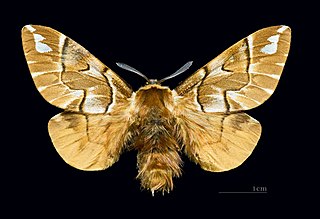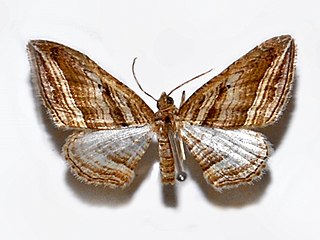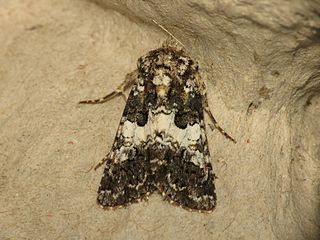
Endromidae is a family of moths. It was long considered to be a monotypic family, containing just one species, the Kentish glory, Endromis versicolora, found throughout the Palaearctic region. The family now consists of several genera and about 30 species, all former members of the family Bombycidae.

Agrotis is a genus of moths of the family Noctuidae. The genus was erected by Ferdinand Ochsenheimer in 1816. A number of the species of this genus are extinct.

Axia, the gold moths, is a genus of moths whose precise relationships within the macrolepidoptera are currently uncertain, but they currently are placed within the superfamily Drepanoidea. Uniquely, they have a pair of pocket-like organs on the seventh abdominal spiracle of the adult moth which are possibly sound receptive organs. They are quite large and brightly coloured moths that occur only in southern Europe and feed on species of Euphorbia. Sometimes they are attracted to light. The genus was first described by Jacob Hübner in 1821.

Scotopteryx is a genus of moths of the family Geometridae described by Jacob Hübner in 1825. It is suspected that some species currently placed here actually belong in Entephria.

Evergestis is a genus of moths of the family Crambidae described by Jacob Hübner in 1825. A number of species are pests, including the cross-striped cabbageworm, a pest of cole crops such as cabbage.

Titanio is a genus of moths of the family Crambidae.
Antha is a genus of moths of the family Noctuidae. The genus was described by Staudinger in 1892.
Aventiola is a monotypic moth genus of the family Erebidae described by Staudinger in 1892. Its only species, Aventiola pusilla, was first described by Arthur Gardiner Butler in 1879. It is found in Japan and south-eastern Siberia.

Drasteria is a genus of moths in the family Erebidae.

Hadena is a genus of moths of the family Noctuidae erected by Franz von Paula Schrank in 1802. About 15 species are native to North America, while over 100 are distributed in the Palearctic realm.
Hepatica is a genus of moths of the family Noctuidae. The genus was described by Staudinger in 1892.

Pseudohermonassa is a genus of moths of the family Noctuidae. Some species were formerly placed in Xestia.

Gynaephora is a genus of "tussock moths", also known as the Lymantriinae, within the family Erebidae. They are mainly found in the Holarctic in alpine, Arctic and Subarctic regions, and are best known for their unusually long larval development period. The life-cycle of Gynaephora groenlandica was once believed to take fourteen years, but subsequent studies reduced it to seven, still a very slow development rate that is extremely rare in the Lepidoptera. The caterpillars have five instars, with each instar lasting a year.
Ocnerogyia is a monotypic moth genus in the subfamily Lymantriinae. Its only species, Ocnerogyia amanda, is found in Iran. Both the genus and the species were first described by Staudinger in 1892.
Dasypteroma is a monotypic moth genus in the family Geometridae. Its only species, Dasypteroma thaumasia, is found in Spain. Both the genus and species were first described by Otto Staudinger in 1892.

Entephria is a genus in the geometer moth family (Geometridae). There is no unambiguous common name for these moths; like many other members of their subfamily Larentiinae, they are sometimes called "carpets". The genus was erected by Jacob Hübner in 1825.
Eumera is a genus of moths in the family Geometridae described by Staudinger in 1892.

Lomographa is a genus of moths in the family Geometridae. The genus was erected by Jacob Hübner in 1825.

Philereme is a genus of moths in the family Geometridae erected by Jacob Hübner in 1825. It is the only genus in tribe Phileremini.

Dyspessa is a genus of moths belonging to the family Cossidae. It was described by Jacob Hübner in 1820.












